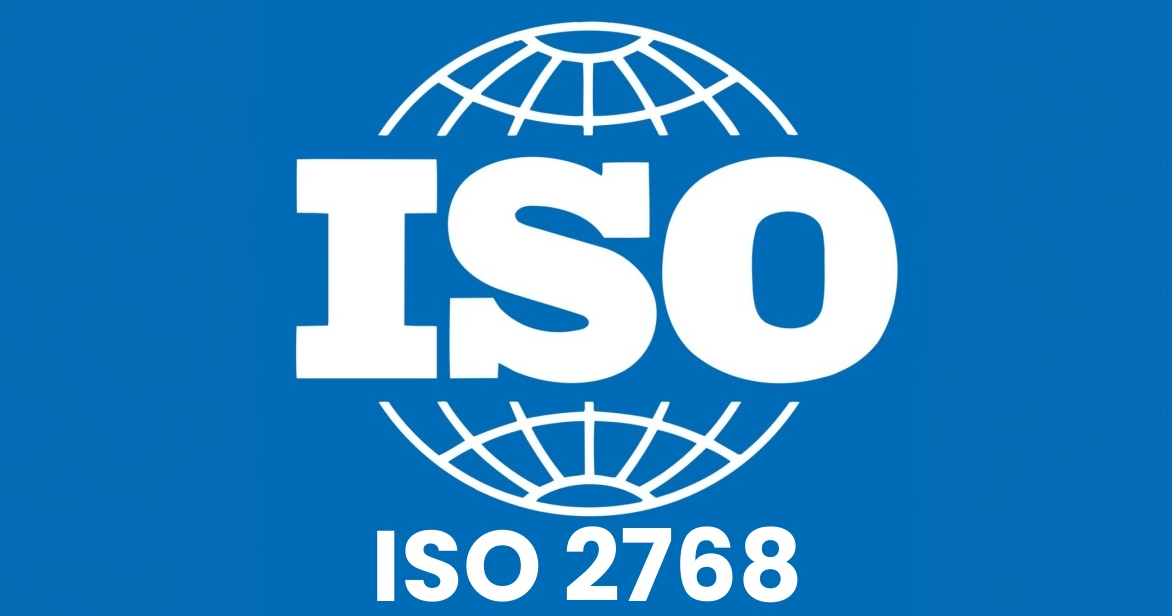Applying ISO 2768 Tolerances in Manufacturing
 Jan 22,2025
Jan 22,2025

ISO refers to the International Organization for Standardization. It is a set of internationally agreed guidelines that help industries to work in a consistent way. The guidelines are standardized measurements, for example about quality, safety, environment, energy, health and many more. It ensures that products, services, operations or environment are safe, good quality and trustworthy. ISO 2768 is one of them which defines mechanical tolerance. This article provides more information about the guidelines, their significance in manufacturing and other important aspects.

What is ISO 2768? Explained
ISO 2768 standard defines the tolerance of mechanical parts. It identifies different levels and types of tolerance of parts.
Overview of ISO 2768 Standard
ISO 2768 defines general mechanical tolerances in engineering drawings. It defines standardized measurements for linear, angular, and geometrical measurements. In manufacturing, ISO2768 is utilized in simplifying designs and production. It is used particularly for those components which do not require high precision machining
What is the Significance of ISO 2768 in Manufacturing?
In manufacturing, it helps in defining linear, angular measurements of part. It also defines geometrical tolerances for designs that lack individual tolerance specifications. It offers a structure to achieve acceptable precision machining. It also reduces inconsistencies while comprising manufacturing costs
Is ISO 2768 Still Valid Today?
Yes, it is still valid today and is one of the globally recognized standards. It is commonly used for identifying tolerances for linear and angular measurements in engineering drawings
ISO 2768-mK: Meaning and Importance
ISO 2768-mK is a subset standard of 2768. This standard explains tolerances for linear and angular dimensions.
What is ISO 2768-mK?
In ISO 2768-mK, M represents medium tolerance, and K represents tolerance class for features such as chamfer heights and external radii.
ISO 2768-mK Tolerance PDF
ISO 2768-mK tolerance standard is available online and can be downloaded from the link below
https://www.dau-components.co.uk/doc/General_Tolerances_-DIN_-ISO_-2768.pdf
ISO 2768-mK vs ISO 2768: Key Differences
It is the standardized measurements for tolerance values for linear, angular dimensions. While ISO 2768-mK is its subset. It defines medium tolerances for geometrical features. The major differences lie in tolerance class, and the areas where these standards focus like ISO2768 is generic while ISO 2678-mK focus on medium tolerance and the applications. ISO 2768 applies for manufacturing metal and plastic parts. And ISO 2768-mK is for designing components
What is the Difference Between ISO 2768-1 and ISO 2768-2?
The differences between these two standards are discussed below:
ISO 2768-1: Tolerances for Linear and Angular Dimensions
The main purpose of ISO 2768-1 is to simplify the drawing and to avoid writing tolerance in each dimension. For example, for linear dimensions it explains external and internal sizes, Dia or radii. For angular dimensions it explains angles
ISO 2768-2: Geometrical Tolerances for Features
ISO 2768-2 also simplifies drawings. It specifies general tolerance for straightness, flatness, circular, and cylindrical parts. It is usually used for chamfer and radius tolerance created by removing material
Key Differences Between ISO 2768-1 and ISO 2768-2
|
Differences |
ISO 2768-1 |
ISO 2768-2 |
|
Defines |
general tolerances for linear and angular dimensions |
geometrical tolerances, like flatness, or straightness |
|
Purpose |
It identifies variation for the size, or placement |
It shows deviations for geometrical parts |
|
Use |
For linear and angular dimensions |
For chamfer and radius tolerance. Especially with no tolerance indication, and are hard to assemble and function |
|
Representations |
Uses four category: fine (f), medium (m), coarse (c), and very coarse (v) |
Used for categories, High (h), Medium (K), and Low (l). |
ISO 2768 Part 1: Tolerances for Linear and Angular Dimensions
Tolerance Chart for Linear Dimensions
|
Permissible deviation in nominal length |
Tolerance limit |
|||
|
Fine (f) |
Medium (m) |
Coarse (c) |
Very coarse (v) |
|
|
More than 0.5 to 3 |
±0.05 |
±0.1 |
±0.2 |
- |
|
More than 0.5 to 3 mm |
±0.05 |
±0.1 |
±0.3 |
±0.5 |
|
More than 3 to 6 mm |
±0.1 |
±0.2 |
±0.5 |
±1 |
|
More than 6 to 30 mm |
±0.15 |
±0.3 |
±0.8 |
±1.5 |
|
More than 30 to 120 mm |
±0.2 |
±0.5 |
±1.2 |
±2.5 |
|
More than 120 to 400 mm |
±0.3 |
±0.8 |
±2 |
±4 |
|
More than 400 to 1000 mm |
±0.5 |
±1.2 |
±3 |
±6 |
|
More than 1000 to 2000 mm |
±0.5 |
±1.2 |
±3 |
±6 |
|
More than 2000 to 4000mm |
- |
±2 |
±4 |
±8 |
Chamfer and Radius tolerance
|
Permissible deviation in nominal length |
Tolerance limit |
|||
|
Fine (f) |
Medium (m) |
Coarse (c) |
Very coarse (v) |
|
|
More than 0.5 to 3 |
±0.2 |
±0.2 |
±0.4 |
±0.4 |
|
More than 0.5 to 3 mm |
±0.5 |
±0.5 |
±1 |
±1 |
|
More than 6 mm |
±1 |
±1 |
±2 |
±2 |
Tolerances for Angular Dimensions
|
Permissible deviation in nominal length |
Tolerance limit |
|||
|
Fine (f) |
Medium (m) |
Coarse (c) |
Very coarse (v) |
|
|
Up to 10mm |
±1ᵒ |
±1ᵒ |
±1ᵒ30’ |
±3ᵒ |
|
More than 10 to 50 mm |
±0ᵒ30’ |
±0ᵒ30’ |
±1ᵒ |
±2ᵒ |
|
More than 50 to 120 mm |
±0ᵒ20’ |
±0ᵒ20’ |
±0ᵒ30’ |
±1ᵒ |
|
More than 120 to 400 mm |
±0ᵒ10’ |
±0ᵒ10’ |
±0ᵒ15’ |
±0ᵒ30’ |
|
More than 400mm |
±0ᵒ5’ |
±0ᵒ5’ |
±0ᵒ10’ |
±0ᵒ20’ |
ISO 2768 Part 2: Geometrical Tolerances
Tolerances for Straightness and Flatness (ISO 2768-2)
|
Nominal length |
Tolerance limit |
||
|
h |
k |
l |
|
|
Up to 10mm |
0.02 |
0.05 |
0.1 |
|
More than 10 to 30 mm |
0.05 |
0.1 |
0.2 |
|
More than 30 to 100mm |
0.1 |
0.2 |
0.4 |
|
More than 100 to 300 mm |
0.2 |
0.4 |
0.8 |
|
More than 300 to 1000 mm |
0.3 |
0.6 |
1.2 |
|
More than 1000 to 3000 mm |
0.4 |
0.8 |
1.6 |
Tolerances for Perpendicularity, Symmetry, and Circular Run-Out
|
Nominal length |
Tolerance limit |
||
|
h |
k |
l |
|
|
Up to 100mm |
0.2 |
0.4 |
0.6 |
|
More than 100 to 300 mm |
0.3 |
0.6 |
1 |
|
More than 300 to 1000 mm |
0.4 |
0.8 |
1.5 |
|
More than 1000 to 3000 mm |
0.5 |
1 |
2 |
|
Nominal length |
Tolerance limit |
||
|
h |
k |
l |
|
|
Up to 100mm |
0.5 |
0.6 |
0.6 |
|
More than 100 to 300 mm |
0.5 |
0.6 |
1 |
|
More than 300 to 1000 mm |
0.5 |
0.8 |
1.5 |
|
More than 1000 to 3000 mm |
0.5 |
1 |
2 |
|
Nominal length |
Tolerance limit |
||
|
h |
k |
l |
|
|
|
0.1 |
0.2 |
0.5 |
ISO 2768-2 Tolerance Chart for Geometrical Features
All the general tolerance mentioned above for ISO 2768-2 helps in selecting the right tolerance level that is best suited to the requirements in manufacturing,
Applying ISO 2768 in CNC Machining
It can be applied in CNC machining tolerance and drawing. It helps in simplifying and specifying tolerance and to meet the required standard dimension of each part.
Implementing ISO 2768 on CNC Drawings
Implementation of ISO 2768 on CNC drawing has many benefits.
- It reduces the requirement to individually set the tolerance level of each part.
- It minimizes the mistakes and ensures that part has met the standard dimension without continuous reiteration.
- It reduces cost by eliminating over-tolerance
- It helps to minimize the occurrence of part defect or reworking.
How to Adjust CNC Machine Parameters Based on ISO 2768
CNC Machine parameters are adjusted to linear and angular precision dimensions. These tolerance levels of precision are used when specific tolerance is not mentioned. The tolerance class are as:
- Fine (f): The most precise level
- Medium (m): A medium precision level
- Coarse (c): A coarse precision level
- Very coarse (v): The least precise tolerance level
ISO 2768 Medium and Fine Tolerances for Precision
The standard medium and fine tolerance indicates the level of precision in parts. Medium tolerance (
 Tel/WeChat:
Tel/WeChat:  Email:
Email: 
 Home
Home
 What Is Tooling in Manufacturing? Types & Design
What Is Tooling in Manufacturing? Types & Design 







